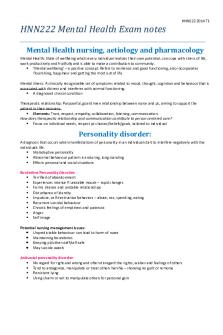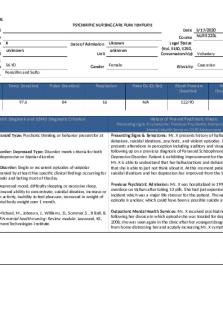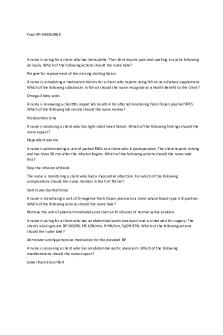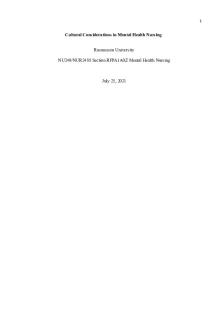Basic Mental Health Nursing Concepts PDF

| Title | Basic Mental Health Nursing Concepts |
|---|---|
| Author | Michelle Abraham |
| Course | Adult Health II |
| Institution | AdventHealth University |
| Pages | 3 |
| File Size | 101.9 KB |
| File Type | |
| Total Downloads | 35 |
| Total Views | 176 |
Summary
Download Basic Mental Health Nursing Concepts PDF
Description
ATI Mental Health Nursing CH 1 Basic Mental Health Nursing Concepts: 1) Obtain a psychosocial history a. Perception of client’s own health, beliefs about illness and wellness b. Activity/leisure activities, how the client passes time c. Use of substances/substance use disorder d. Stress levels and how they cope with stress, any support systems? Assess the client’s cultural health care beliefs, practices, and values a. Any culture-specific foods? Specific beliefs or practices pertaining to health care? b. Spirituality and religious beliefs: find out about them 2) Do a mental status examination (MSE) a. CHECK LEVEL OF CONSCIOUSNESS i. Are they alert? Able to fully respond by opening eyes and using normal tone of voice and speech? ii. Are they lethargic? LETHARGIC: able to open eyes but is drowsy and falls asleep readily iii. Are they stuporous? STUPOROUS: Client requires vigorous or painful stimuli like pinching a tendon or rubbing the sternum to elicit a brief response; may be unable to respond verbally iv. Are they comatose? COMATOSE: unconscious and doesn’t respond to painful stimuli. 1. Decorticate: Flexion and internal rotation of upper extremity joints and legs.
2. Decerebrate: Neck and elbow extension, wrist and finger flexion
3) Check physical appearance: Personal hygiene, grooming, clothing choice. Appropriately dressed for environment (Not wearing a jacket when it’s 100 degrees outside for example), and wellkempt, clean. 4) Check behavior for involuntary and voluntary body movements and eye contact a. Mood: The emotion the client is feeling
b. Affect: An OBJECTIVE expression of mood, such as a flat affect or lack of facial expression 5) Check cognitive and intellectual abilities: is the client orientated to time, person and place? 6) Check the client’s memory, both RECENT AND REMOTE a. Immediate: repeat a series of numbers or a list of objects b. Recent: recall recent events such as visitors from the current day or purpose of admission c. Remote: Ask the client to state a fact from the past that is verifiable like their DOB or mother’s maiden name d. Assess client’s level of knowledge e. Assess client’s ability to calculate. For example, count backwards from 100 in intervals of 7. f. Assess client’s ability to think abstractly like interpreting a cliché phrase g. Perform an objective assessment of client’s perception of illness h. Assess the client’s judgment on his answer to a hypothetical question i. Assess the client’s rate and volume of speech 7) Standardized Screening Tools a. MMSE=mini mental state examination i. Orientation to time and place ii. Attention span check and ability to count backward by 7 iii. Registration and recalling of objects iv. Language including naming objects, following commands, and ability to write b. Glasgow Coma scale: Highest possible value is 15 which means they are awake and responding appropriately. A SCORE OF 7 or LESS INDICATES A COMA 8) Children and adolescents: Check their view of the world as safe, whether they mastered developmental tasks, and their coping skills a. Check for mood, anxiety, developmental, behavioral, and eating disorders; check for selfinjury or suicide risks. b. Use the HEADSSS assessment tool: Home environment (relationships at home ok?), Education/employment (Is the client employed? What’s school performance like?), Activities (Does the child participate in sports and interact with peers?), Drugs and Substance use (Does the client use alcohol, tobacco, marijuana, or other substances?), Suicide/Depression (Is the client at risk of suicide or self-injury? Any signs of depression?), Savagery (Is the client exposed to abuse in home or violence in neighborhood?) 9) Older adults: Check their functional abilities (doing things independently, socializing w/ others), Environmental factors, economic and social status, and physical assessment. a. Scales for older adults: Geriatric depression scale, MMSE alcoholism scale, pain assessments including FACES pain reading, McGill pain questionnaire, and Advanced Dementia pain scale. b. Assess for their living space: quiet space w/ adequate lighting for impaired vision and hearing. 10) DSM-5: A diagnostic and statistical manual of mental disorders used to identify diagnoses and criteria to guide assessment, plan, implement, and evaluate care 11) Therapeutic strategies in the Mental Health Setting
a. Counseling: using therapeutic communication skills, problem solving, crisis intervention, stress management b. Milieu therapy: orienting client to physical setting, identify rules and boundaries of setting, ensure safe environment, assist in appropriate activities c. Promotion of self-care activities d. Psychobiological interventions: administer prescribed medications, provide teaching to client/family about meds, monitor for adverse effects and effectiveness of pharmacological teaching e. Cognitive and behavioral therapies: modeling, operant conditioning, systematic sensitization f. Health teaching: teaching social and coping skills g. Health promotion and health maintenance: assist client with cessation of smoking, monitor other health conditions h. Case management: coordinating holistic care to include medical, mental health, and social services....
Similar Free PDFs

Uworld Mental Health Nursing
- 168 Pages
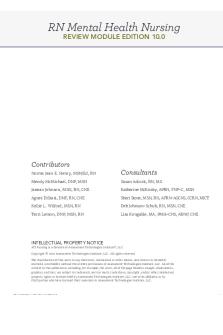
ebook for mental health nursing
- 219 Pages
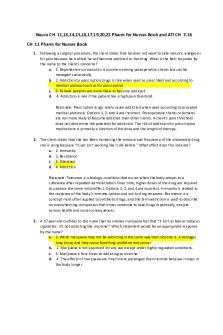
ATI TEST - mental health nursing
- 38 Pages
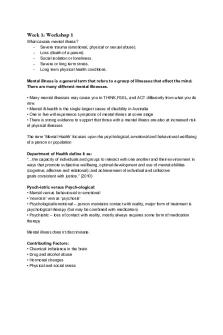
Nursing and Mental Health 1 Notes
- 62 Pages

Mental Health
- 44 Pages

Basic Concepts for Biostatistics
- 92 Pages

Basic Financial Concepts
- 19 Pages
Popular Institutions
- Tinajero National High School - Annex
- Politeknik Caltex Riau
- Yokohama City University
- SGT University
- University of Al-Qadisiyah
- Divine Word College of Vigan
- Techniek College Rotterdam
- Universidade de Santiago
- Universiti Teknologi MARA Cawangan Johor Kampus Pasir Gudang
- Poltekkes Kemenkes Yogyakarta
- Baguio City National High School
- Colegio san marcos
- preparatoria uno
- Centro de Bachillerato Tecnológico Industrial y de Servicios No. 107
- Dalian Maritime University
- Quang Trung Secondary School
- Colegio Tecnológico en Informática
- Corporación Regional de Educación Superior
- Grupo CEDVA
- Dar Al Uloom University
- Centro de Estudios Preuniversitarios de la Universidad Nacional de Ingeniería
- 上智大学
- Aakash International School, Nuna Majara
- San Felipe Neri Catholic School
- Kang Chiao International School - New Taipei City
- Misamis Occidental National High School
- Institución Educativa Escuela Normal Juan Ladrilleros
- Kolehiyo ng Pantukan
- Batanes State College
- Instituto Continental
- Sekolah Menengah Kejuruan Kesehatan Kaltara (Tarakan)
- Colegio de La Inmaculada Concepcion - Cebu



